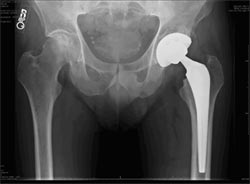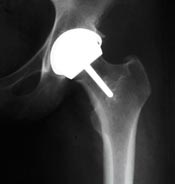Hip replacement surgery, as we know it today, has been performed for more than five decades, allowing millions of patients to move without pain and with extended range of motion. Having a hip replaced is a major surgical procedure performed in the operating room. You will be instructed on pre-surgical preparations prior to the date of your operation. To speak with an orthopedic surgeon about hip replacement surgery, call (206) 341-3000.
- Joint Replacement Mobility/Social Assessment Questionnaire (Please fill out this form before your appointment.)
During Hip Replacement Surgery
Before surgery, you may be given a spinal anesthetic, which will knock out all feeling below your waist during your operation. If desired you will be given a sedative to help you relax or even sleep during surgery. Your surgeon will then make a three- to six-inch incision over your hip to expose the deeper tissues. The major muscles around the hip joint are not cut but rather surgically separated exposing the joint capsule. The capsule is divided and the damaged "ball" or head of the thigh bone (femur) dislocated and removed.

Damaged bone and cartilage in the "socket" are removed and the socket is smoothed and enlarged slightly to receive the artificial metal shell implant. At times a screw is used to enhance fixation. A highly polished socket liner made of polyethylene plastic, metal or ceramic is then secured inside of the socket shell.
Your surgeon will then create a narrow channel about five inches long into the top of your thigh bone (femur) to receive the stem and ball of your new implant. This part of the device is secured in place with or without cement. If bone cement is not used, the materials of the stem will be made of a rough porous titanium alloy that allows your natural bone to grow into it and help stabilize it.
The materials in your new ball-and-socket joint press against one another easily to help restore motion in your hip. The length of your operation may range from one to two hours.
Minimally Invasive Hip Replacement Surgery
Minimally invasive (or "less invasive") hip replacement is a less invasive surgical procedure that allows your surgeon to perform surgery through a smaller incision. The benefits of this surgery are an incision measuring two-and-a-half to four inches that may result in:
- Less blood loss
- A faster recovery
- A shorter hospital stay than the average three-day stay with a traditional approach
Not all patients are candidates for minimally invasive surgery. Factors such as patient body weight, prosthesis size, and the complexity of hip disease may influence the appropriateness of a less invasive approach. Your surgeon will talk to you about whether or not you are a candidate for this type of surgery.
Anterior Hip Replacement Surgery
Anterior hip replacement surgery at Virginia Mason's Orthopedics Department offers the most direct approach to the hip joint, which preserves the integrity of the muscles and offers the opportunity to perform a minimally invasive procedure. Advantages of this approach include:
- Reduced risk of dislocation with no post-operative dislocation precautions
- Quicker recovery
- Faster return to normal daily activities
Anterior hip replacement is more technically demanding, and may result in a longer surgical procedure with increased blood loss. Studies indicate that this approach may provide a longer-lasting prosthesis with reduced risk of limping and improved short-term and mid-term results. To learn more about the anterior hip replacement surgery option, or to schedule a consultation with an orthopedic surgeon, call (206) 341-3000.
Partial Hip Replacement
A partial hip replacement may be indicated if hip disease exists only on the ball of the hip joint or if there is a fracture that has removed the ball of the natural hip. In these instances, the head of the femur is removed as it is during a traditional hip replacement and replaced. The socket in the pelvis remains natural and intact.
Hip Resurfacing

Hip resurfacing is a newer surgical technique being performed at Virginia Mason, primarily in younger patients who have less degeneration in their hip joint. During this procedure the socket portion of the hip joint is replaced as it is during traditional hip replacement surgery. The "ball" or head of the femur is resurfaced with a cobalt chrome metal surface. The new surface is attached to the head of the femur with cement. There is a small metal stem within the leg bone.
Bilateral Hip Replacement
Occasionally, a patient may need both hips replaced. When appropriate, Virginia Mason surgeons will perform both hip replacements during one operation. Whereas bilateral total knee replacements are frequently done at the same time with two separate surgical teams, bilateral hip replacements are performed by one team doing one hip surgery after the other. The operation is done under a single anesthetic and takes two to three hours. Rehabilitation after bilateral hip replacement is similar to unilateral total hip surgery but often requires an additional day in the hospital.
After Hip Replacement Surgery
Inpatient Physical Therapy
Following surgery, you will be taken to a recovery room where your vital signs will be monitored. Once you have recovered from surgery, you will be moved to a regular hospital room where you may stay for 72 hours or longer.
On the same day as your surgery, a physical therapist will help you sit up in bed and show you how to perform light exercises. You may even stand and walk a short distance with a cane or walker on the first day. Each day you are in the hospital, and several times a day, the physical therapist will work with you and help you walk a little bit farther. Your road to recover begins with these simple exercises that will eventually help you regain strength and functional use of your hip.
Outpatient Physical Therapy
Prior to joint replacement surgery, many patients attend a physical therapy orientation in Virginia Mason's Department of Physical Medicine and Rehabilitation or Sports Medicine Clinic. The orientation provides patients with helpful information, including safety recommendations (rearranging frequently used items for easier reach), assistive devices (front-wheeled walker, raised toilet seat) and joint-specific exercises.
Your surgeon or a physical therapist will talk to you in more detail about exercises to do at home, either on your own or with the help of home health services. Rehabilitation services also are available through Virginia Mason's Department of Physical Medicine and Rehabilitation and Sports Medicine Clinic.
Much of the success of your surgery will depend upon adherence to the exercises given to you that will help you for regaining strength and mobility in your hip. Your rehabilitation may take 12 weeks. The key is to go slowly and perform only the exercises prescribed for you.
- Physical Therapy (Sports Medicine)
- Physical Medicine and Rehabilitation
Risks of Hip Replacement Surgery
All precautions to ensure patient safety are taken prior to every operation at Virginia Mason. However, as with any surgery, some risks remain. There are, for example, risks of:
- Infection
- Excessive blood loss
- The development of blood clots
- Dislocation
- Nerve damage
The incidence of these risks occurring in patients is very small.
There also is the risk of the implant loosening over time. This risk occurs in less than one percent of hip replacements after they have been implanted for five years. Your surgeon will talk to you in more detail about the risks associated with your surgery.
Many patients ask how long the implant will last. That answer must take into account several factors, including your age, physical condition and activity level. Because these devices are made with strong materials that provide a secure fit, implant survival of 20 years is not an unreasonable expectation.